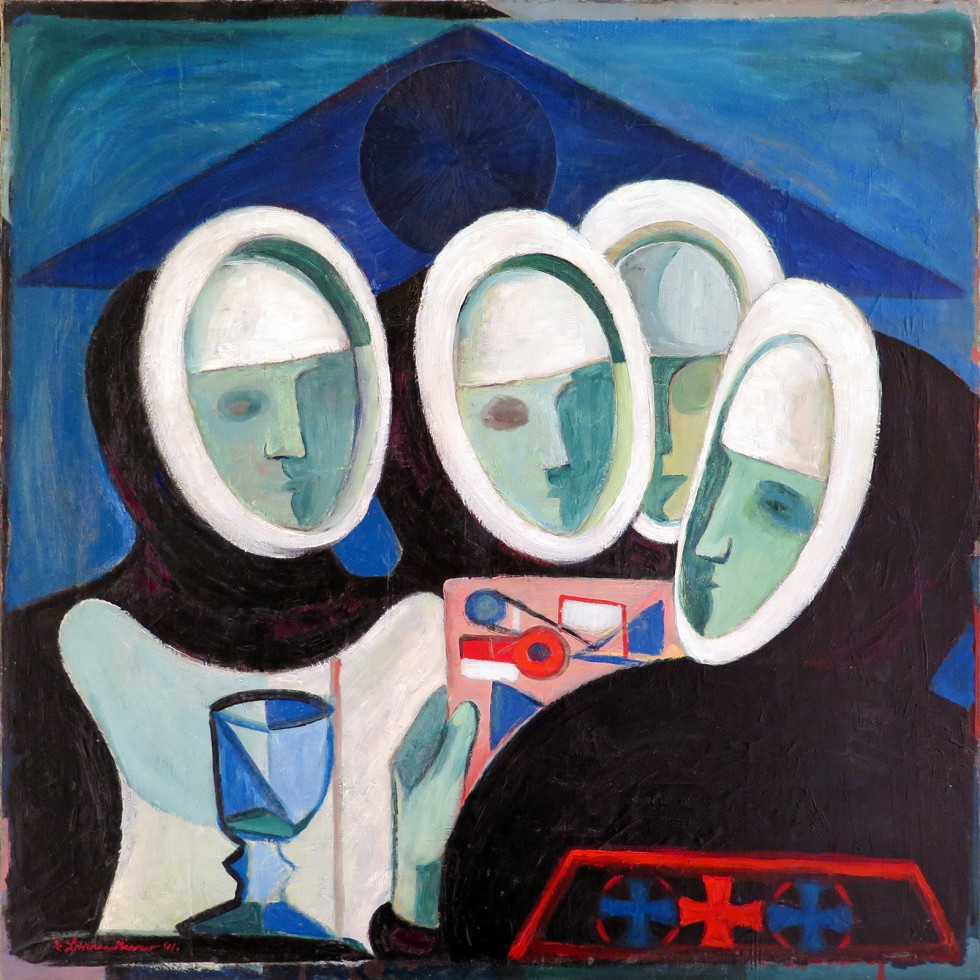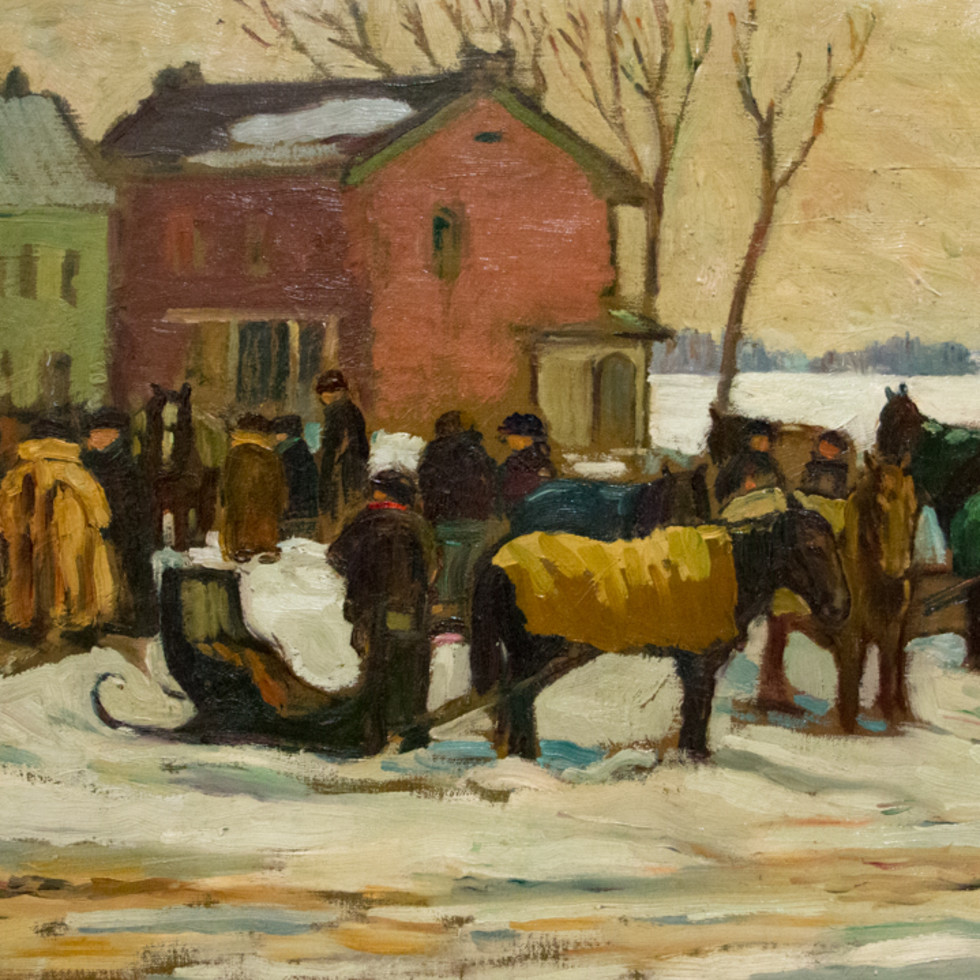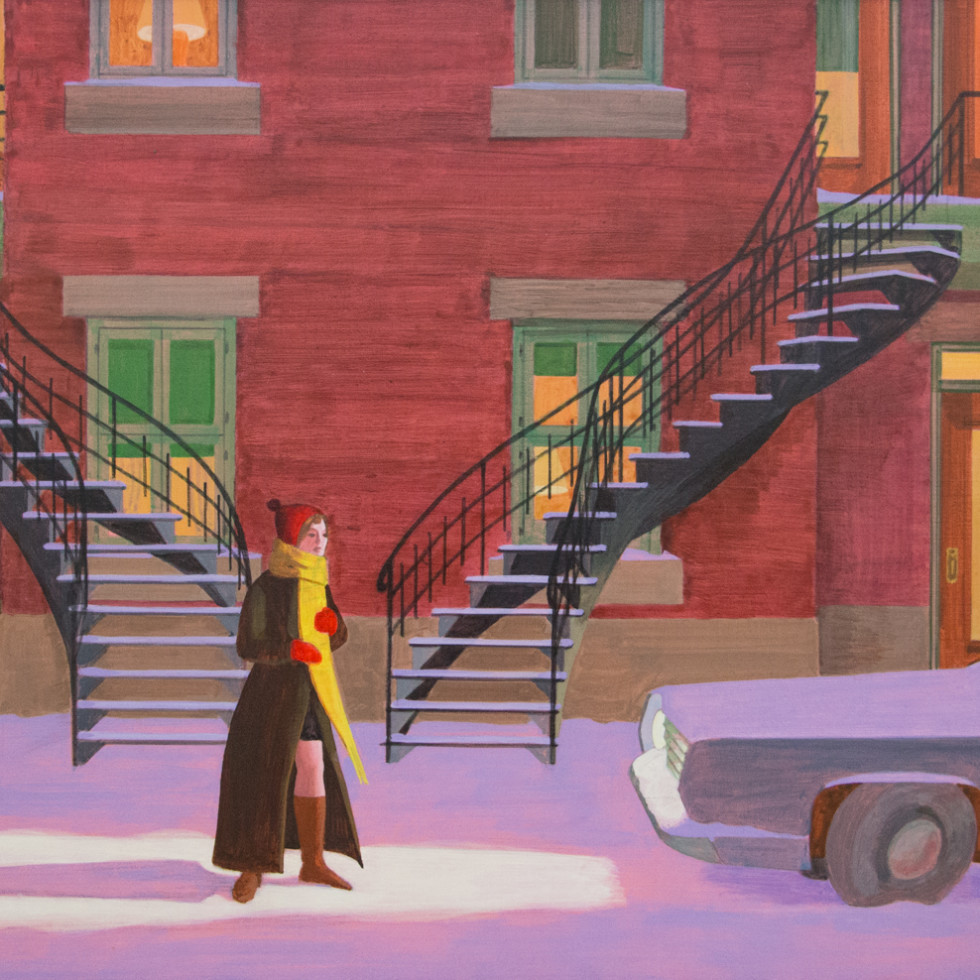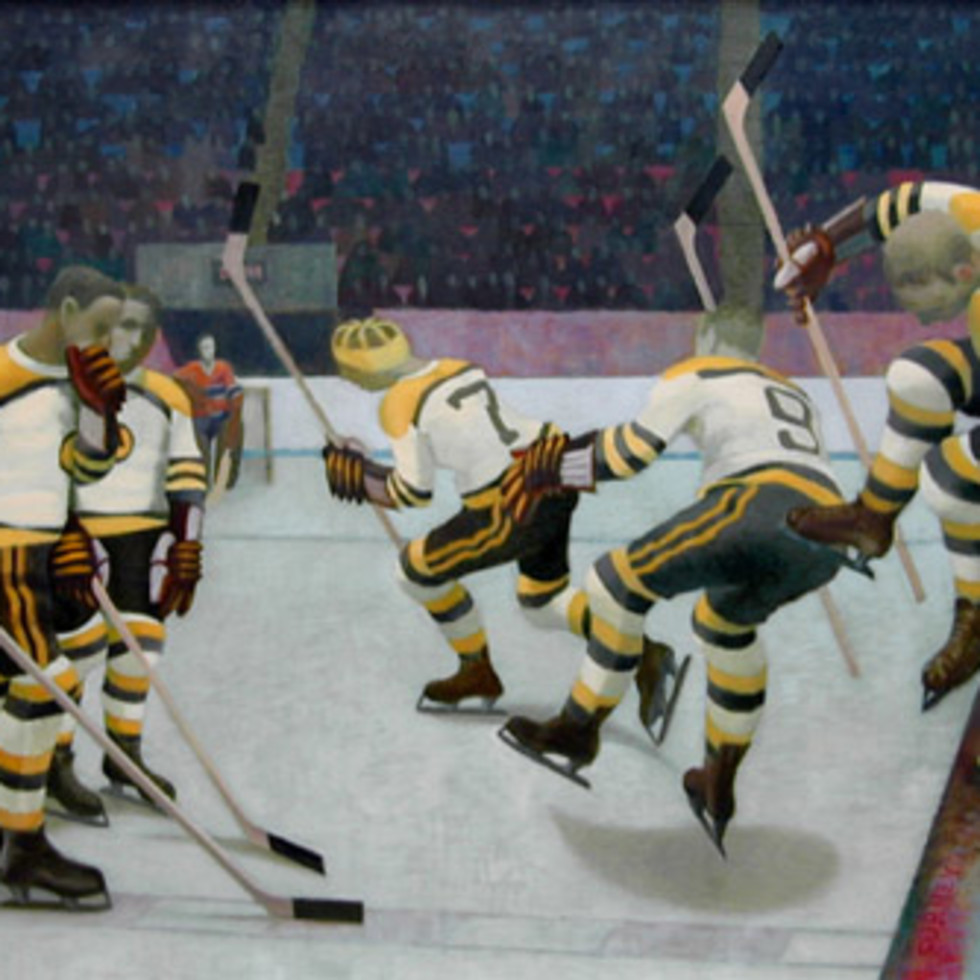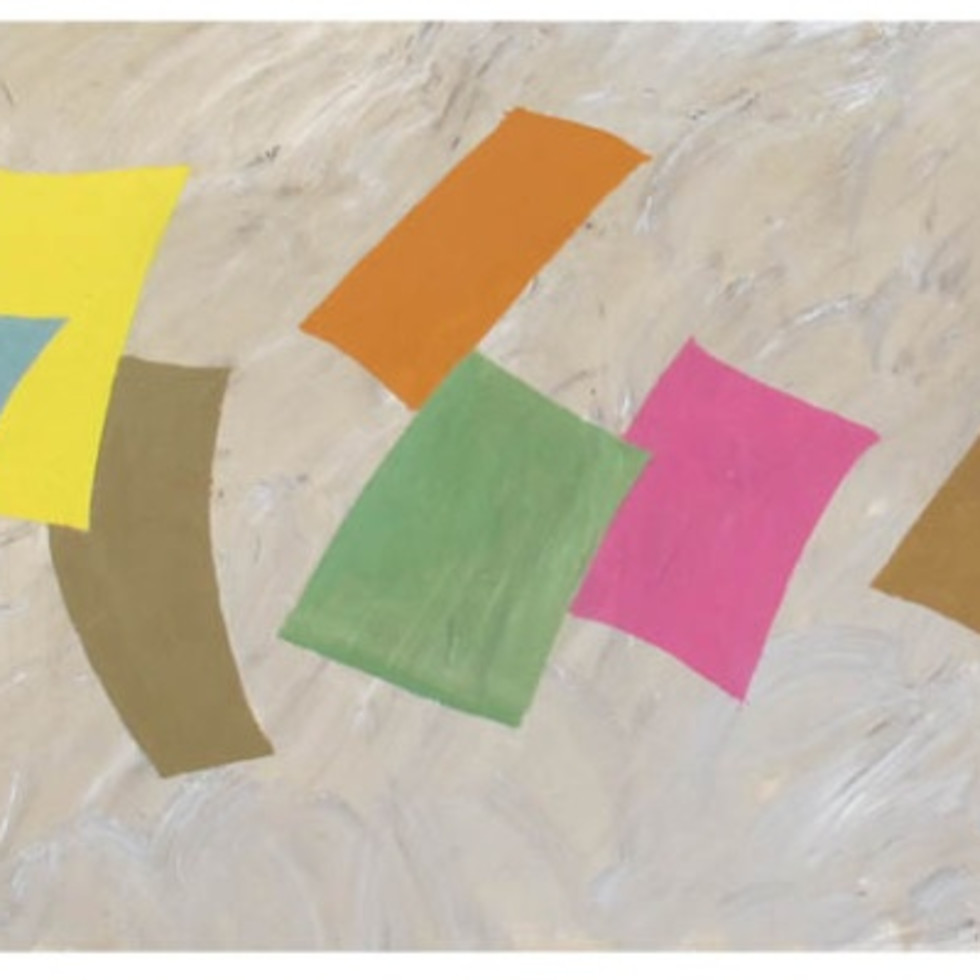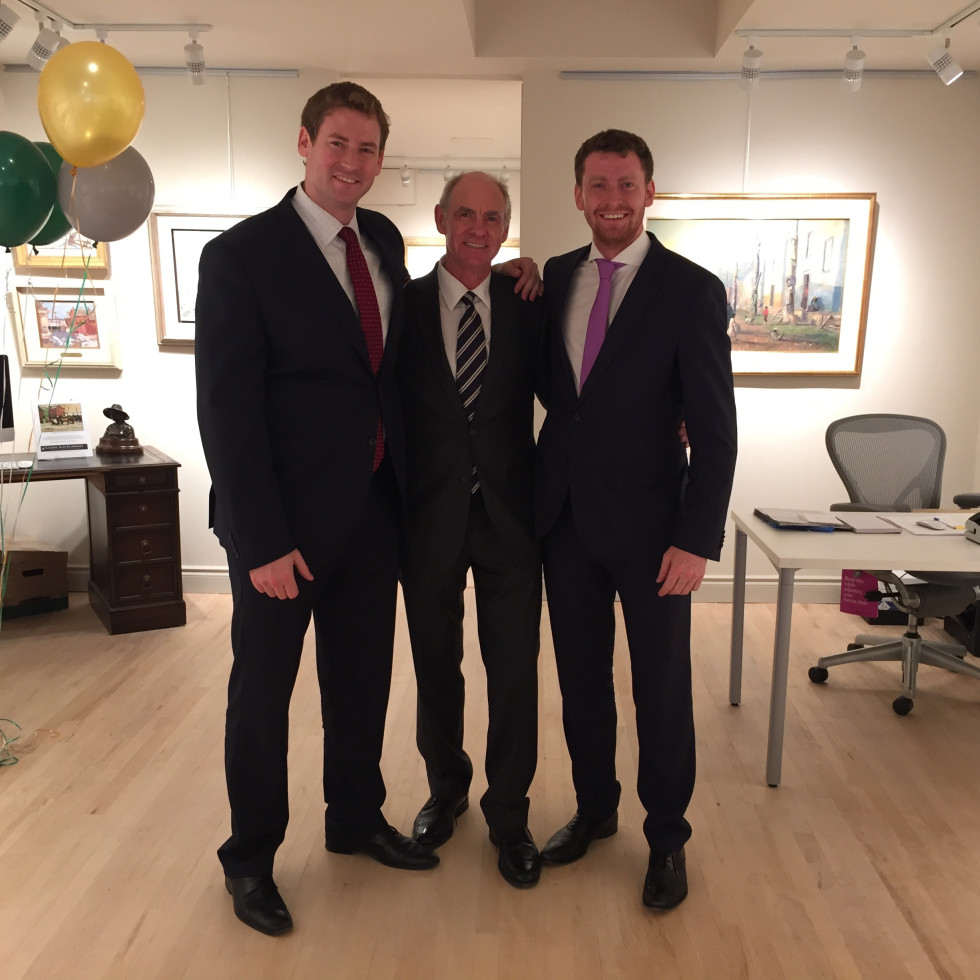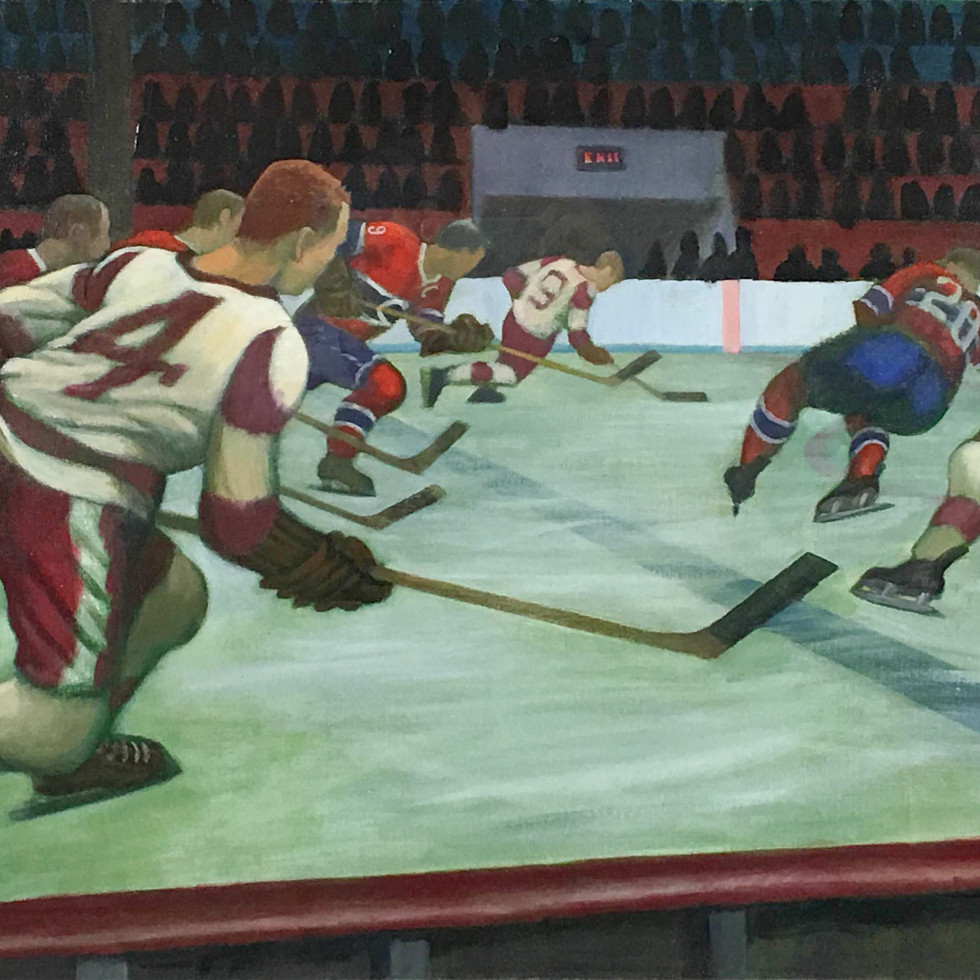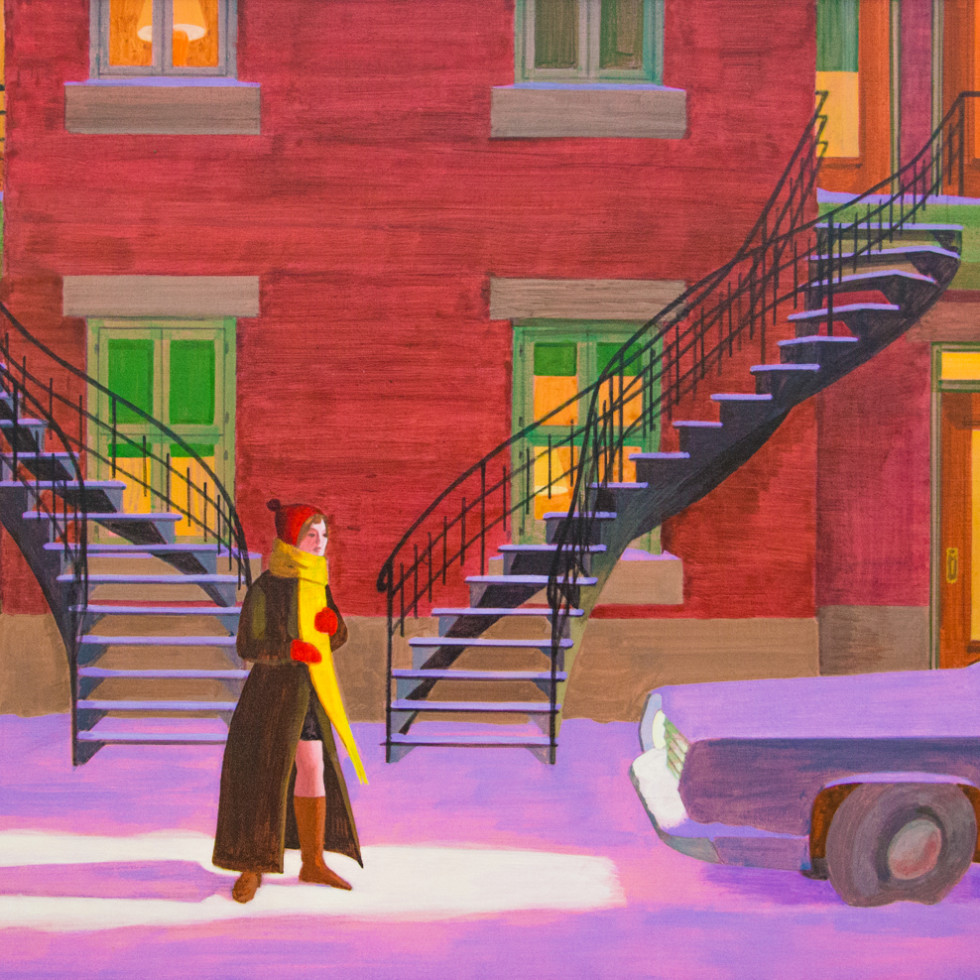Philip Surrey
 Each individual is alone, cut off. Each wonders how others cope with life. A work of art is a particularly complex statement, valuable because it is packed with meaning… Like icebergs, four-fifths of our personalities lie below the surface; of the fifth that shows, only part can be expressed in conversation. The only effective outlet for all deeper feelings and thoughts is art.
Philip Surrey
Each individual is alone, cut off. Each wonders how others cope with life. A work of art is a particularly complex statement, valuable because it is packed with meaning… Like icebergs, four-fifths of our personalities lie below the surface; of the fifth that shows, only part can be expressed in conversation. The only effective outlet for all deeper feelings and thoughts is art.
Philip Surrey
When Philip Surrey was inducted into the Order of Canada in 1982, the citation read:
"Ever since settling in Montreal in 1937 and becoming a founding member of the Contemporary Arts Society, he has been the leading exponent of urban landscape painting in Canada. His Montreal street scenes convey an emotive vision of the modern city, with its anonymous crowds and individual solitudes. His expressive style and a poetic humanitarianism constitute a unique contribution to Canadian art."
Surrey started to paint seriously at the age of sixteen and, from the first, urban life was his dominant subject: a watercolour dated May 1, 1927 has street lights and a café window reflected in the wet pavement of Portage Avenue in Winnipeg. During five decades of painting, he found his own way to being contemporary by seeing Montreal, as Guy Viau observed in Jacques de Roussan’s Philip Surrey (Collection Panorama, 1968) “as a theatre and himself as director of its anonymous actors. . . . His people . . . submit like good creatures to the impersonal signals of traffic lights and crossings. Their thoughts are their own, like their loneliness. But again and again as he walks through the streets of Montreal, he watches its people. He studies their goings and comings. . . .as they pass and meet. But not with a judging eye. An eye that feels at one with them. A fraternal eye.”
Philip Surrey liked to tell his friends, especially the many writers among them, that they would have a hard time finding any character in fiction who had a childhood as filled with remarkable travels and romantic misadventures as his own. He had a point. He was born on Oct. 8, 1910, at Calgary General Hospital, baptized Philip Henry Eugene de Warenne de Guerin Surrey, and put down for Marlborough, his maternal grandfather’s school. Many years later, he said, “I count it the first and perhaps most important piece of luck in my life that I escaped this fate, for, if I had emerged from an English Public School at eighteen without money or influence I would have been utterly unfit for life in my native land.” His mother, Kate de Guerin, who was born in Bombay, had inherited a small income and set out to see the world, travelling alone. When funds got low, she worked as an English governess for titled or wealthy European families. Harry Surrey, Philip’s father, was the son of a Confederate veteran in the American Civil War who alighted in England after General Lee’s surrender. Harry had run away from school to go to sea and, at eighteen, joined the British army and fought in the Boer War with distinction. He went trading in the wilds of East Africa, on to Hong Kong and Shanghai, then to Australia as a cow puncher, westwards to Italy, Spain, France, Morocco, Cuba, Mexico, sometimes working as a soldier of fortune, before going north to Alaska and prospecting for gold.
Kate and Harry met in Vancouver in 1909, married in Victoria, and honeymooned in Hawaii. Dreaming of owning land and starting a family, they went to Calgary and bought a half square mile of land. By the time Philip arrived a year later, they realized they did not like living as settlers, but the fact that their son was born in Canada could never be taken away from him.
Philip had his first birthday in Java, where his father managed a coffee plantation. For the next eight years, Philip travelled from one place to another as Harry changed jobs or Kate took him on visits to her relatives. By the time he was enrolled at prep school in England in 1919, Philip had already visited Australia, British Columbia, California, France and Switzerland, Singapore, Malaysia, Calcutta, and several parts of India. During most of this time, his parents lived in splendid hotels and Philip grew up among the potted palms and three-piece orchestras of the likes of the Raffles in Singapore and the Grand in Calcutta. He was always the Surrey boy, the stranger, the outsider and lonely without friends his age, but exotic – he had ridden camels and elephants, walked about with a pet orangutang, and conversed with snake-charmers. His formal education was patchy but his mother had taught him to read, write, sketch, and he’d acquired some French and German from her and a smattering of several other languages in lounges, gardens and bazaars. Philip had a gift for listening as well as observing.
While Kate was settling Philip at school in England, Harry sent a letter from Singapore saying he had fallen in love with another woman and asked for a divorce. The letter was unexpected and his request was denied. Without money or prospects in England, and gripped by an unreasoned fear that Harry would try to kidnap Philip and she would lose him too, Kate secretly returned to Canada with her son, landing at Montreal on April 16, 1921, and worked as a housekeeper on a Manitoba farm until she found a succession of teaching jobs in one-room country schools north of Winnipeg. Philip was instructed to tell everyone that his father was dead. It was not until 1972 that Surrey learned through a chance encounter, leading him to his father’s widow in Baltimore, that Harry had become General Manager of the Lipton Tea Co. for North and South America and the Far East (including China, the Federated Malay States, the Dutch East Indies, Australia and New Zealand) before he died of cancer in London when Philip was twenty.
Surrey left school at fourteen, moved into Winnipeg on his own, lodged in boarding houses, and earned his living by delivering newspapers and running errands while he taught himself illustration and design through copying from Cosmopolitan magazines. He took his drawings to Brigden's of Winnipeg and was accepted as an apprentice in its commercial art department. Brigden's was the firm that made all the illustrations and engravings for Eaton's Western Catalogue. At Brigden's, he swept the floor, mounted drawings with rubber cement, drew borders for Eaton's Spring and Summer Catalogue for 1927, and helped illustrate the women’s sections of the 1928 and 1929 catalogues. After work, he attended evening classes at the Winnipeg School of Art given by George Overton and LeMoyne Fitzgerald. Bill Winter and Henry Simpkins, who also worked at Brigden’s in more senior positions and sketched in watercolours at lunch, supper and weekends, asked him to come along with them. Philip caught their fever and knew that he too wanted to be a fine artist. Discovering that the nighttime was his best time, he wandered the streets of Winnipeg after ten o’clock and painted by street and restaurant lights. He made three hundred watercolours in that first year as well as a great many pencil sketches of streets and people. He and Winter used to discuss whether one could become a great painter if one stayed in Winnipeg, painting back lanes, telephone poles, garbage cans, automobiles, and decided that, yes, one could. At that point, he had not visited a good gallery or even seen adequate colour reproductions of any major paintings until he discovered the works of Nicholas Poussin, the great seventeenth century master of French classicism, in old copies of The Studio purchased from a second-hand store. In later life, Surrey often remarked on how raw and provincial his beginnings as an artist had been, but he had found his own way, immediately and intuitively, to the nightscape of cities and the people who inhabit them and to Poussin who remained the strongest influence on his sense of what a painting could be and should do.
Restless in Winnipeg, Surrey took a job at Cleland-Kent Engraving in Vancouver in the autumn of 1929 as a fully qualified and highly paid commercial artist. On the train, his life was catapulted back into the upper-middle class when he met and joined forces with DeLarue Edmonds, a well-connected Edmontonian with a mass of social introductions in Vancouver. The stock market collapsed three weeks after they arrived, but its effects were not immediately evident on the west coast. Not foreseeing the eventual reduction of his income by 75%, Surrey wrote to his mother telling her she could stop teaching, come and live with him and that he would maintain her in the style to which she had been raised. He had no idea what he was doing to himself – he would continue to support his mother for more than forty years of frequent and ill-timed extravagances, few thanks, and constant quarrels. They had not lived together for more than six years but to her, he was still a child and would always remain so. To escape her, he plunged into art classes five nights a week, studying composition with J.W.G. MacDonald and life drawing in charcoal on manilla with Frederick Varley. Varley emphasized the importance of the light and encouraged using thin, firm outlines for the light side of the forms and broad, soft lines marking the edges of the shadow areas. This shadow was not filled in and the effect was of considerable reflected light. Philip soon became a regular visitor to Varley’s home and a close friend.
When poverty engulfed both of them in Vancouver, Varley and Surrey made their way east separately and then shared a single basement room in Montreal in 1937. After a year of paying the rent, buying paints and canvasses for Varley and himself, and supporting his mother in her own separate apartment by freelance commercial artwork, Surrey was hired by the Montreal Standard as assistant to Hazen Sise, who was transforming its old roto-gravure section to the new style photojournalism under the direction of its publisher John McConnell and editor Davidson Dunton. Surrey soon took over from Sise and did his best with limited space and resources to produce a Life magazine for Canadians. Though Surrey had only evenings and weekends for his painting, he never thought of himself as a Sunday painter but as a part-time professional, temporarily obliged to earn his living at something else. He set to work to revive his childhood bilingualism and made himself at home in both French and English art circles, quickly reacquainting himself with Fritz Brandtner, whom he had known at Brigden’s, and developing friendships with Jean Palardy, Jori Smith, Jeanne Rhéaume, Jean-Paul Lemieux, Stanley Cosgrove, Goodridge Roberts, Eldon Grier, and John Lyman. When Lyman founded the Contemporary Art Society, Surrey was named Treasurer. After A.Y. Jackson bought one of his paintings, he used some of the money to buy a drawing from Alfred Pellan that remained one of his most treasured possessions through the rest of his life.
For the next twenty-five years, Surrey divided his working hours between the Standard (or its successor, Weekend Magazine) and his painting with notable success in both fields. At John McConnell’s request, he turned down a commission as a war artist in order to bring photographs of the war and of war workers into Canadian homes week by week. He and Mavis Gallant, his assistant, selected and captioned some of the first photographs of the Holocaust to be published in North America. In 1947, Surrey and Gallant collaborated with Gabrielle Roy in producing a photo essay of Bonheur d’occasion for the Standard, which resulted in its being translated and becoming a best-seller in English as The Tin Flute. Surrey’s friendship with Roy drew him to sketch and paint sites and sights drawn from her Montreal novels. After his move to Grosvenor Avenue in 1949, what he saw on his nighttime walks home from the Standard’s downtown offices through St-Henri, up Greene Avenue to lower Westmount and westward through Westmount Park provided the background for his paintings. In the foreground, providing the human interest and the dramatic elements in his canvas theatre were the people he encountered along the way. Surrey often said that the arts interested him because of their ability to distil the essence of another person’s experience of life. In a journal entry of this period, he wrote, “Each individual is alone, cut off. Each wonders how others cope with life. A work of art is a particularly rich and complex statement, valuable because packed with meaning. Our curiosity about how others manage their money is only a tiny part of our curiosity as to how they manage all their affairs. Like icebergs, four-fifths of our personalities lie below the surface; of the fifth that shows, only part can be expressed in conversation. The only effective outlet for all deeper feelings and thoughts is art.”
Philip Surrey married Margaret Day on June 22, 1939 and they spent a honeymoon weekend with Goodridge and Marion Roberts at the Lyman’s summer cottage. From his marriage until his death, Surrey carried on an intense, often fractious, deeply analytical conversation with Margaret about art and its connectedness to the rest of life. Margaret Day’s intellectual and erotic influence on his work is largely under-appreciated as are her close connections with the wartime and postwar literary life of Montreal. Margaret was a Montreal financier’s daughter who travelled to the Soviet Union in the thirties, turned Marxist, and became a school teacher to the children of St-Henri. Surrey met her shortly after her affair with Norman Bethune ended on his departure for China. Margaret was imbued with a sense of the tragedy of existence and had developed a fervent belief that consolation could be found only in music, poetry, fiction, and painting. Thwarted by fragile health in her own ambitions to become first a pianist and then a writer, Margaret put her best efforts into encouraging Philip not just to resolve painterly problems but also to capture in brush strokes the existential angst that their close friends Gabrielle Roy, Mavis Gallant, and Brian Moore were putting into words. To this, he added the sexual anxieties and erotic stimuli that he relished in his own favourite reading, the novels of Georges Simenon.
Surrey’s paintings in the forties and fifties are notable for their sombre colours, their mysterious shadows, their eeriness, and the loneliness and secrecy of their subjects. But they are also distinguished by the poise and stillness of their composition and their ability to convey meaning and order amid conflict and confusion.
On June 23, 1964, John McConnell asked Surrey if he would like the chance to paint full time before he grew any older. In an act of extraordinary generosity and support, his employer suggested he stay home and paint but still remain on the staff of what was now Weekend Magazine and draw his salary as usual, thereby enabling him to work without worrying over sales and money. John McConnell remarked that he “wanted to do something for Canadian art,” which Surrey found very flattering. Twelve years of financial freedom were handed to him in the briefest of conversations: Surrey was only fifty-three and ordinarily would have had to go on working till retirement at sixty-five.
John Lyman said that he’d never met anyone like Surrey for seeking out problems, “If there is a problem that's where he'll head.” Surrey celebrated his astonishing good fortune by tackling the newest and biggest subject and the one that posed the greatest compositional difficulty in all of Montreal – Place Ville Marie and the young women who gathered there to eat their lunches, parade their dresses, chat, bare their arms and legs, and attract men.
Rural landscapes were the only thing that ever came quickly to Surrey and with so little effort that painting them was almost recreational and holiday-like. Because of that, he avoided them unless some subject or texture in them proved irresistible – as did the ice fields when he travelled through the Arctic in 1959 or the beaches in the Townships and Maine. Everything else came slowly with his eye being caught by some effect of light and colour that he scribbled into the notebook that always accompanied him.
The scribble was organized on paper, a little bigger and stronger; sometimes in black and white, charcoal or black chalk and wash; sometimes in colour, usually acrylic, usually on 9” x 12” paper. Then he’d try several more compositions, using the same elements and also adding or dropping some of the vertical, horizontal, angular or curved shapes which described the forms of cars, buildings, people. The elements were then lit by artificial light of various colours. For Surrey, twilight had a special charm and he’d try adding two or three kinds of light from different artificial sources – neon signs, lampposts, traffic lights – to increase the complexity and also the interest of the piece.
The final composition was then developed starting on paper or masonite with either acrylic or oil and usually in a 12” x 16” format. If it expanded beyond this stage either by the addition of figures or changes in the relationship of elements, the next stage would be the same size or larger but painted on raw linen canvas that he stretched and primed himself. Surrey’s compositions, or designs as he preferred calling them, were directly related to and dependent on the proportions 1:2, 2:3, 3:4, 4:5, and twice 4:7 which was different from all the others. When transferred to larger canvasses, these proportions were sized 24”x 48”, 20” x 30”, 40” x 60”, 24” x 32”, and 48” x 72” inches. If the principal illumination was cold, he used a Venetian red ground to glow through and give warmth to dark areas or shadows. If it was a warm light, his ground was oxide of chromium to cool the darks. Dark areas were painted thinly, sometimes glazed so the ground color contributed to the effect. Light areas were thicker and highlighted with a loaded brush.
Though the picture started from what he had seen and scribbled, it eventually included effects of colour or movement that he remembered from other observations. Surrey believed no two paintings, even of the same things, need be or should be the same in colour. The light differs every few minutes, every hour, every day and it gives the colour. Moreover, even a flat surface is never the same hue all over because the light strikes it at a whole series of different angles and Surrey usually chose to accentuate the variations in order to add variety and interest. Sometimes cars, trees, buildings, people from different sketches were combined; sometimes the place where he saw the original action and colour was so much changed, usually simplified, that it is no longer recognizable. But the painting is always recognizably, unmistakably Surrey.
He brought each painting downstairs and hung it, sometimes for weeks, where he and Margaret read, listened to music, drank, ate and lived with it daily. Eventually he could see what more needed to be done, took it back upstairs and completed it. “The Baseball Players” established a record of sorts by hanging over the dining room table for over a year with all the players nude before Surrey took it back upstairs to the studio and clothed them. Margaret knew a painting was truly finished only when he’d say grudgingly, “Not too bad, better than I thought it was.”
By 1965, Surrey felt he was doing the best work of his life and celebrated it with a one-man show at Gilles Gauvreau’s Galerie Martin. It sold out. To Surrey’s great surprise and immense satisfaction, John Lyman attended in his wheelchair. A second show in April 1967 was equally successful. In January 1970, Gilles Corbeil became Surrey’s exclusive dealer in Quebec and remained so until he closed his gallery in 1985. At 75, Surrey felt his own career drawing to a close. There had been twenty-four one-man shows and he had taken part in one hundred and twenty-one group shows. His work hung in many public and private collections. He’d received the Centennial Medal in 1967, an honorary degree from Concordia University in 1981, and was made a member of the Order of Canada in 1982. By 1985, he’d begun to lose weight inexplicably and experience problems with balance as well as difficulty in seeing some things. He continued to work on long-standing compositions but was drawn more and more to works on paper that were influenced by the dance-like compositional style of the Japanese film director Akira Kurosawa and the colour and lighting choices of his cinematographers. Philip Surrey joined the Hemlock Society and died by his own hand in 1990 when his eyesight grew too dim for him to draw any more. He spent the last year of his life painstakingly destroying everything that he felt was inadequate or incomplete. On hearing of his death, his longtime friend and fellow painter Molly Lamb Bobak said, “He was a modest man but he knew he was a damn fine painter. He knew the difference between electric light and the light of the sky. He knew the look of leaves as they rustled in the wind.”
In his book, Four Decades of Canadian Painting, Paul Duval writes, “Surrey has recorded the human comedy in Montreal’s streets, taverns, cafes and homes. No other Canadian artist has painted life in the city with such constancy and authority. He has shown it in all seasons, weather and moods, with candidness and a highly original outlook. . . . Philip Surrey’s paintings are as much Montreal as Wyeth’s are Pennsylvania or Vermont and Colville’s is New Brunswick. . . . Surrey has found more visual richness at home than many widely travelled artists have found in their searches. The style and technique with which he presents his material, however, have undergone subtle changes and enrichments through the decades. He has remained loyal to the classic materials of watercolours and oil paint, but his approach to composition, texture and, specifically, colour, has become increasingly personal and evocative. During the 1960's he produced a series of works which captured the light-studded mystery of night in the metropolises as no one else has done. He has brought together the fluorescent worlds of traffic lights, neon tubing, cast shadows, and passing forms reflected in shop windows, and integrated them into harmonious and crisply composed wholes.” That was written in 1972 when Surrey was at the height of his powers and had more than a decade of very good work ahead of him. The fact that his reputation did not spread as far and wide as it deserved in his own lifetime is partly due to the fact that three separate attempts to win him more recognition through the publication of illustrated catalogues of his work were beset by the financial difficulties of the publishers and the artist’s health problems. But, more regrettably, it also has something to do with the hostility many Canadian cultural nationalists showed toward the urban and urbane in art through much of the second half of the twentieth century, a trend that has recently undergone a sea change in our literature and is overdue in our painting. When that change comes, when doctrinaire and puritanical impulses again give way to the cosmopolitan fearlessness and the less rancorous, more amusing and bawdier sexuality of the mid-century, Surrey will surely begin to be as widely recognized and loved in Canada as Edward Hopper is in the USA. While he shares much of Hopper’s solitude and introspection, spareness and simplicity, Surrey is rarely as bleak and never as nostalgic nor as repressed. The fact is that even his most solitary characters vibrate, gesture, reflect moments of a continuous dance between men and women. This dance is open-ended, unfinished, a perpetual process, a mysterious forcefulness that releases the dancers and their viewers into belonging to something greater than our individuated selves.
Copyright Terry Rigelhof and Galerie Walter Klinkhoff 2004
Philip Surrey Exhibitions at Klinkhoff
PHILIP SURREY
31st Annual Retrospective Exhibition
September 18 - October 2, 2004.
Exhibition, Le peintre dans la ville (Musée d'art contemporain, Montréal. October 28 - November 28, 1971 and Centre Culturel Canadien, Paris 20 January - 20 March, 1971).
Paintings
-
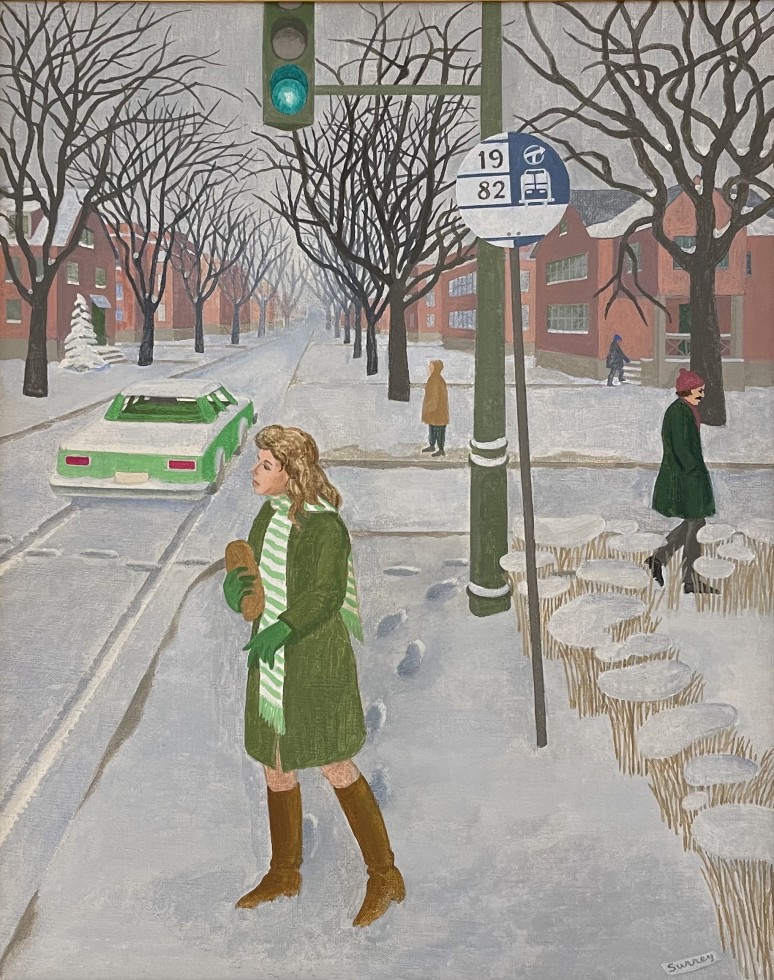 Bus Stop, 1982 Oil on canvas 20 x 16 in
Bus Stop, 1982 Oil on canvas 20 x 16 in
50.8 x 40.6 cm $40,000 -
 Au Petit Lunch, 1972 (circa) Oil on canvas 18 x 24 in
Au Petit Lunch, 1972 (circa) Oil on canvas 18 x 24 in
45.7 x 61 cm $40,000 -
 Grosvenor & Sherbrooke, the Pink Umbrella, 1972 Oil on canvas 24 x 20 in
Grosvenor & Sherbrooke, the Pink Umbrella, 1972 Oil on canvas 24 x 20 in
61 x 50.8 cm $40,000 -
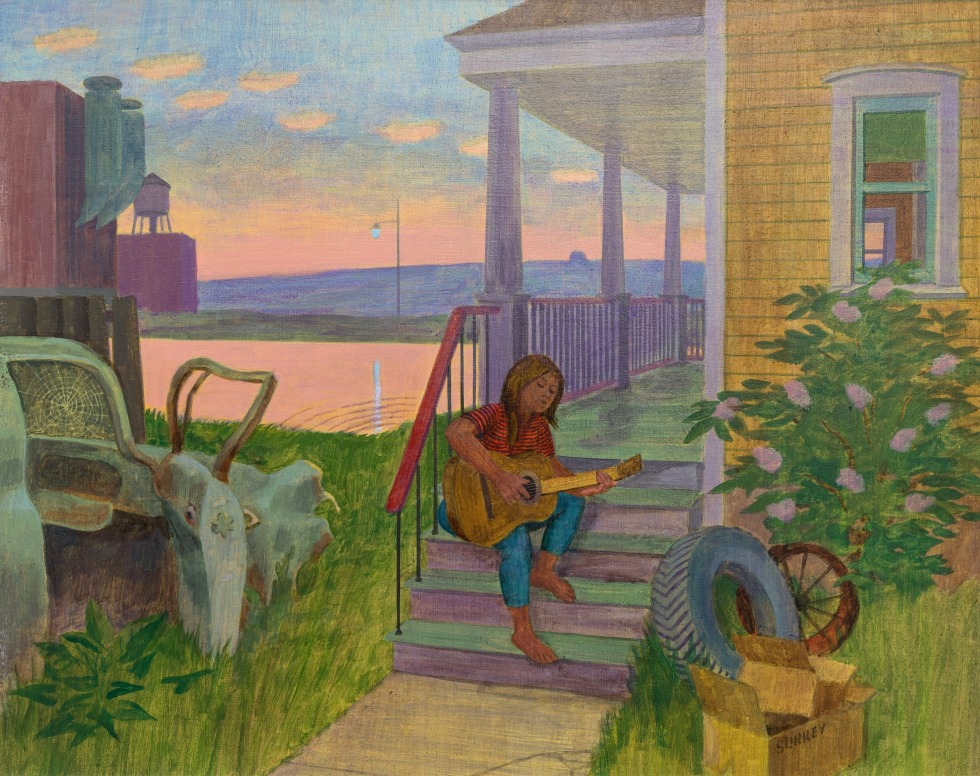 Guitarist, Lachine Canal, 1972 Acrylic on board 16 x 20 in
Guitarist, Lachine Canal, 1972 Acrylic on board 16 x 20 in
40.6 x 50.8 cm $22,000 -
 La Plage, 1967 (circa) Oil on board 12 x 18 in
La Plage, 1967 (circa) Oil on board 12 x 18 in
30.5 x 45.7 cm $22,500 -
 Two Girls, 1967 Oil on canvas 20 x 16 in
Two Girls, 1967 Oil on canvas 20 x 16 in
50.8 x 40.6 cm $40,000 -
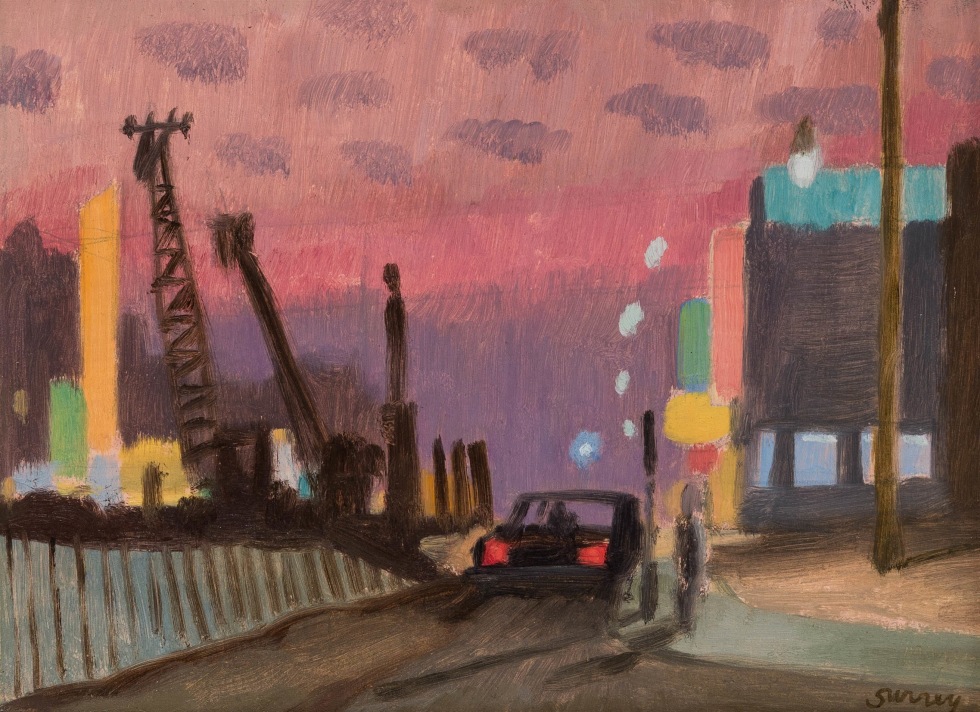 Decarie (probably at Sherbrooke Street), 1966 (circa) Oil on board 6 x 8 in
Decarie (probably at Sherbrooke Street), 1966 (circa) Oil on board 6 x 8 in
15.2 x 20.3 cm $9,500 -
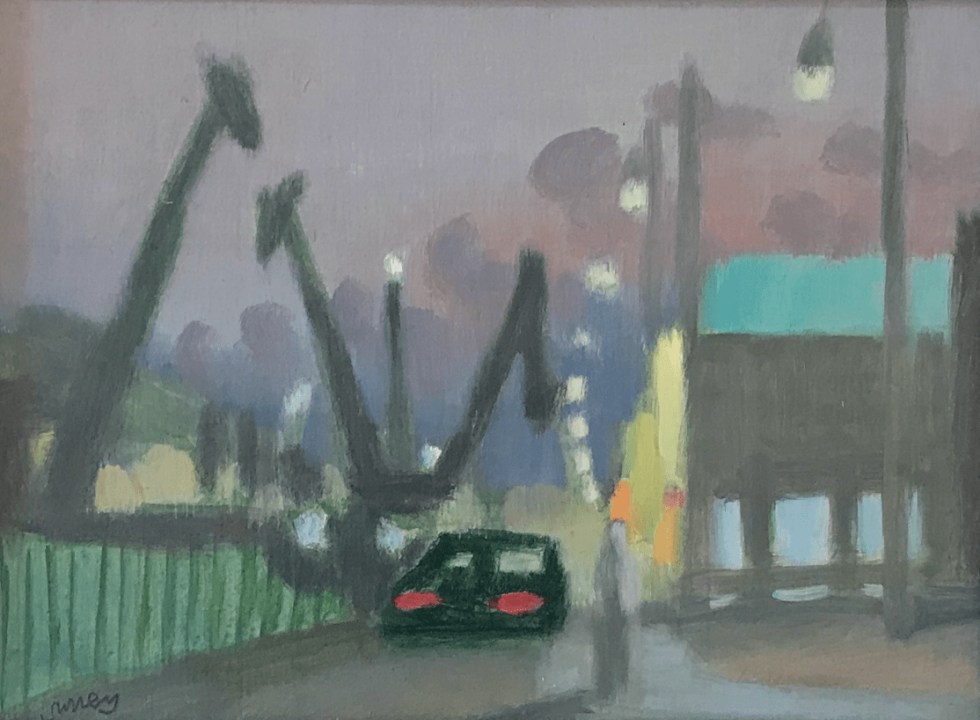 Decarie II (probably at Sherbrooke Street), 1966 (circa) Oil on board 6 x 8 in
Decarie II (probably at Sherbrooke Street), 1966 (circa) Oil on board 6 x 8 in
15.2 x 20.3 cm $9,500 -
 Place Ville Marie, 1963 Oil on board 12 x 16 in
Place Ville Marie, 1963 Oil on board 12 x 16 in
30.5 x 40.6 cm $25,000 -
 The Strait of Belle Isle, 1958 Oil on masonite 6 x 8 in
The Strait of Belle Isle, 1958 Oil on masonite 6 x 8 in
15.2 x 20.3 cm $9,500 -
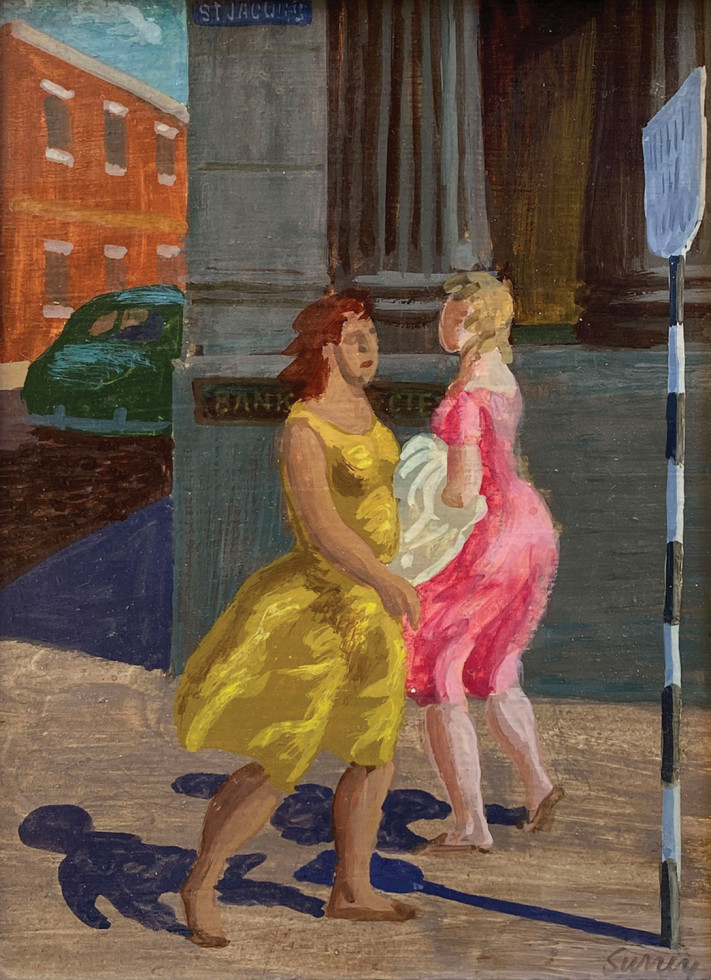 Bank Girls, St. Jacques Street, Montreal, 1955 (circa) Oil on board 8 x 6 in
Bank Girls, St. Jacques Street, Montreal, 1955 (circa) Oil on board 8 x 6 in
20.3 x 15.2 cm $10,500 -
 Gaspé Cabins (Fort-Prével), 1955 Oil on canvas 20 1/8 x 24 in
Gaspé Cabins (Fort-Prével), 1955 Oil on canvas 20 1/8 x 24 in
51 x 61 cm $20,000 -
 Evening on the Beach Oil on masonite 6 x 7 3/4 in
Evening on the Beach Oil on masonite 6 x 7 3/4 in
15.2 x 19.7 cm
$3,000








